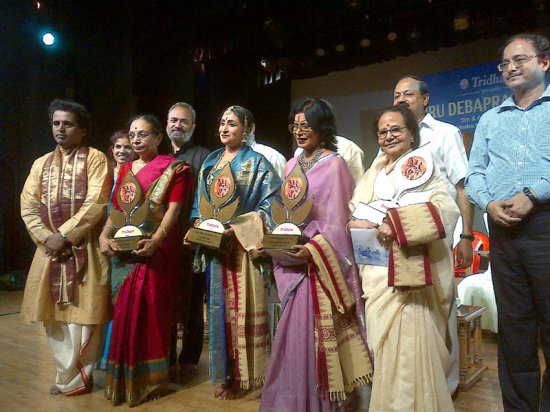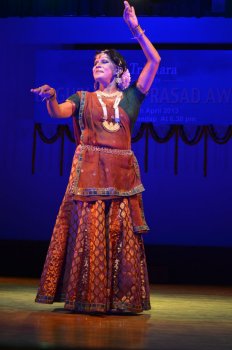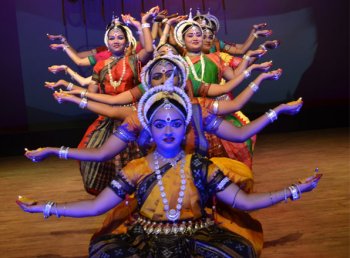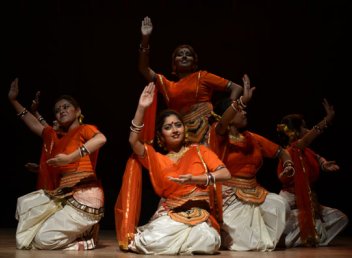
|   |

|   |
6th Guru Debaprasad Award - Ashish Mohan Khokar e-mail: khokar1960@gmail.com Photos courtesy: Tridhara April 13, 2013 Odisha continues to be an active place for dance, festivals and awards. After Delhi, Chennai, Bangalore, it is Bhubaneswar now in term of dance density (number of events, awards, festivals, students, teachers). Nay, Orissi or Odishi today is the second most learnt dance style of and in India, after Bharatanatyam, nationally and internationally and that itself is quite a feat in 50 short years, since the form got formally established and accepted by the national academy for dance, drama and music (the SNA) as a classical one. Four gurus - Pankaj Charan Das, Kelucharan Mohapatra, Debaprasad Das and Mayadhar Raut- are held for its codification, formatting for stage and growth. Of them, thanks to Debada and his ace disciple Indrani Rahman, it first went national and international. Guru Debaprasad Das needs little introduction to the committed or the cursory reader of narthaki, having platformed many gurus (indepth in my Dance History Column that ran for 3 years and in review writings before that for over 10 years, on this portal). He is the main guru who first made Orissi, or Odissi or Odishi, international. Much before Orissi was known even to rest of India, this guru made it international. Thanks to his ace student, the great Indrani Rahman, Debada was propelled into the orbit of world dance and taken to America and Europe, much before any Orissi main gurus had gone abroad. Thus, he is also a pioneer in more ways than one. Did you know this guru was multi-talented? Have you seen sketches of his dances? Have you seen his work on astronomy? I discover such and many more nuggets every time I open the over 70 trunks of the famed Mohan Khokar Dance Collection (www.dancerarchivesofindia.com).  Gajendra Panda, Radha Shridhar, Ashish Khokar, Vyjayanthi Kashi, Shovana Narayan, Aloka Panikar, Ashok Kumar Tripathy Guru Debada died very young because even the gods loved him. At 56 he was gone, leaving a bunch of very distraught though devoted students, like Durgacharan Ranbir and Gajendra Panda. Sure enough, Indrani continued in her mission with vision and many other younger foreigners like Ramli Ibrahim too learnt Odissi after Bharatanatyam, but these two gurus in India remained on ground and have institutionalized the Guru Debada tradition. And now in last few years, guru Gajendra Panda has surpassed all in guru bhakti by instituting awards in memory of his guru, whom he has worshipped like an Eklavya. So to Odisha we all went last week, when mercury soared 42 degrees, to be a part of the 6th Guru Debaprasad Award, a two day function (April 5 & 6) featuring such seniors as gurus Aloka Panikar, Radha Shridhar, Shovana Narayan and Vyjayanthi Kashi. (One for each major form). All were honoured with the 6th Debaprasad Award and performed on the occasion. AIR Delhi top staff artiste, Pt. Kailash Sharma, able successor to Pt. Hariprasad Chaurasia level of art, though a student of Prakash Saxena at the Gandharva Mahavidyalaya, regaled all with a short flute recital, to set the mood. At best of times, guru Gajendra Panda is disorganised! He also doesn’t have many extra hands or volunteers to help with such an ambitious event. But his heart wins all and his devotion to dance is transparent. His main gift and talent lies not in organization, nor even in dancing but in choreography and teaching. Each of his works have that sense of material-from-the- soil and each student fares equally as he has trained them all well. While other festivals and award functions seem to have got more support both from Odisha govt and corporates and thus more established, Gajendra’s awards and festivities is truly a people’s festival. Punctuality and perfectionism is given a go by (like for most of India these words are an illusion!) and generally some anomalies abound like putting an unknown child dancer –no matter how talented - among seniors! That the child proved her mettle very well, saved the day for all involved. Some professionalism will help, although managing all this alone is not easy, though no excuse either. Shovana Narayan began the festival with flair, as only she can. With paltry material she can spin tales of mythology with aplomb. Her material sometimes can be thin but her artistry and showmanship makes for it. Within minutes, she had the audiences in hand, clapping at each single step. Odias are very art loving audiences and respect visiting artistes much. Lot of feet touching happens out of genuine respect and many throng for autographs. In that, Gajendra gave Odia audiences a feast. Audiences in Bhubaneswar are also truly cultured, though the press photographers are not always, blocking view of all at crucial moments.  Shovana Narayan  Ananya Kannan  Tridhara group  Tanushree Shankar’s group Before Shovana, Tridhara group had presented Bande Mataram and it set the tone for the festival with theme of India and Mother India. A passable production. Child dancer Ananya Kannan delighted all with her Orissi in the ten minute relief item (and next day with her equally good Bharatanatyam rendition. She is a natural dancer. Period.) before the huge cast of Tanushree Shankar took over with its Jagaran, a ballet on Vivekananda, concluding again with Vande Mataram. Looking at these works, one felt nostalgic of Uday Shankar days and style, which now Tanushree retains, with her own touch. To maintain a dance-ballet corps or company is not easy and the cast showed how well they work as a team. The Award Ceremony was itself sweet and simple the next day and speeches over (a tad too long, especially with three artistes waiting and a 45 minute delayed start!) Vyjayanthi Kashi took to stage with her over-smiling face and slow-paced Kuchipudi. I use the word “slow-paced” because for most audiences, Kuchipudi is mistaken to be a fast-paced Bharatanatyam! In fact, one Kuchipudi dancer from Bihar said to me 35 years ago, “Ashish, when I dance fast Bharatanatyam, they think it’s Kuchipudi!” Kashi is a seasoned dancer who needs to guard about her lip-syncing because she does not do it fully. Either she sings along, as was the tradition in Kuchipudi, being a melam tradition, or refrains from it altogether. She has come of age as an artiste, having seen her often locally in Bangalore, last 15 years. The best was reserved for the last. Guru Radha Shridhar’s masterly choreographed ‘Shree (how sweet!) Geeta Govind.’ The cast of 12, with beautiful Radha represented by Aishwarya Nityanand, the divine dancer of Bangalore and playful Krishna danced ably by Bianca, were fetching. Even the sakhi, (Aparna Shastry) generally sidelined, had a central role and all others danced well. Guru Radha carried a make-up man all the way and all looked professionally turned out. Alas, a 45 minute unpardonable late start and long list of speakers (Why must everyone on stage speak? When most have nothing new or relevant to speak? ) spoiled the show for this fine group from Bangalore. In the end, less than a dozen people were left and that was very sad for the artistes whose spirits were not any the less diminished as professionals who had come all the way on a two day train journey to showcase their homage to land of Jayadeva. Ratikant Mohapatra, the son and successor of Kelubabu, one of the guests of honour that day, had stayed late (till the show ended at 11 pm!!) and was suggested to present them again in his festival come September, so all Odisha can see this Bharatanatyam tribute to Odisha’s iconic poet. Festivals bring together people and artistes. As govt. agencies don’t have the wherewithal or genuine interest in promoting good art, artistes are now increasingly undertaking their own “cultural exchanges” (“I invite you to my festival, you invite me to yours!” syndrome). This can also sometimes lead to mediocrity, if there is no quality check or chief mentor or selfless advisor with no personal agenda or interest to promote any particular group or dancer but promote good art itself. On the positive side, such festivals and gatherings create ripple effects and audiences in each city benefit. The media is very supportive in Odisha, splashing the award and festival prominently. Volunteers like budding sitarist Miloo drove Vyjayanthi Kashi and myself the next day on the way to the airport to Kelubabu’s house to pay our respects to the memory of the great guru, whose death anniversary it was on the 7th of April. Dr. Mrutyunjaya Rath conducted and compered the two day event with poetic depth and discourse. His voice and style are most pleasing. Guru Gajendra stands complimented for mounting this unique award-cum- festival in memory of his great guru. Long Live, Debada!  Ashish Mohan Khokar, after 40 published books and numerous articles on
dance in the last 30 years, has mentored this award festival as he helps
with many others, nationally and internationally. He has learnt 3
classical styles, served the State as arts administrator (SKP, INTACH,
Festivals of India in Europe) and wrote as critic of the Times of India
for 2 decades in Delhi, then Bangalore. He edits and publishes India's
only yearbook on dance -attendance, now in its 15th year. He is curator
of India's largest dance collection created by his father, late Mohan
Khokar and chairs the Dance History Society. Ashish Mohan Khokar, after 40 published books and numerous articles on
dance in the last 30 years, has mentored this award festival as he helps
with many others, nationally and internationally. He has learnt 3
classical styles, served the State as arts administrator (SKP, INTACH,
Festivals of India in Europe) and wrote as critic of the Times of India
for 2 decades in Delhi, then Bangalore. He edits and publishes India's
only yearbook on dance -attendance, now in its 15th year. He is curator
of India's largest dance collection created by his father, late Mohan
Khokar and chairs the Dance History Society. attendance-india.com |